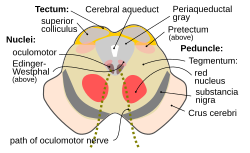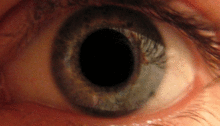Pretectal area
| Pretectal area | |
|---|---|
 Cross section of the midbrain at the level of the superior colliculus. Pretectal area labeled (as pretectum) at right. | |
| Details | |
| Part of | Midbrain |
| Parts | anterior pretectal nucleus, medial pretectal nucleus, nucleus of the optic tract, olivary pretectal nucleus, posterior pretectal nucleus, posterior limitans, commissural pretectal area |
| Identifiers | |
| Latin | area praetectalis |
| MeSH | D066250 |
| NeuroNames | 467 |
| NeuroLex ID | nlx_59721 |
| TA98 | A14.1.08.505 A14.1.08.506 |
| TA2 | 5739 |
| FMA | 62402 |
| Anatomical terms of neuroanatomy | |
In
Location and structure
The pretectum is a bilateral group of highly interconnected nuclei located near the junction of the
Several nuclei have been identified within the pretectum, although their borders can be difficult to define and there has been debate over which regions should be included and their precise names.[1][10][11] The five primary nuclei are: the olivary pretectal nucleus (ON), the nucleus of the optic tract (NOT), and the anterior (NPA), medial (NPM), and posterior (NPP) pretectal nuclei. The NOT consists of relatively large cells and is located between the superior colliculi. The ON is located medial to the NOT and has a tail that extends between the NOT and NPP, which is ventral to the ON.[10] Two additional nuclei have also been identified: the posterior limitans (PLi) and the commisural pretectal area (CPA).[12] While these two regions have not been examined to the same extent as the five primary nuclei, research has shown both the PLi and CPA to receive retinal input, which suggests a role in processing visual information.[13]
Inputs
The pretectum receives significant
The NOT receives input from several regions. From the thalamus the NOT receives inhibitory projections from
Outputs
Many pretectal nuclei share targets of efferent projections. All pretectal nuclei, except for the ON, project to nuclei in the thalamus, subthalamus,
The NOT has efferent projections to the zona incerta of the subthalamus, several nuclei of the pons, medulla, intralaminar nuclei, midbrain, and dorsal and ventral thalamic nuclei. Its bilateral inhibitory projections to the accessory optic system include connections to the lateral and medial terminal nuclei. Projections to the subthalamus are target toward the lateral geniculate nucleus and pulvinar. The NOT projects bilaterally to the superior colliculus, although the ipsilateral connections appear to be more dominant. In addition to these projections, the NOT projects to the vestibular and vestibulocerebellar relay nuclei.[1]
Function
As part of the subcortical visual system, neurons within the pretectal nuclei respond to varying intensities of illuminance and are primarily involved in mediating non-conscious behavioral responses to acute changes in light. In general, these responses involve the initiation of optokinetic reflexes, although the pretectum can also regulate nociception and REM sleep.[12]
Pupillary light reflex

The pupillary light reflex is mediated by the pretectum.[2] This reflex is responsible for the constriction of the pupils upon light's entering the eye. Several pretectal nuclei, in particular the ON, receive illuminance information from the ipsilateral side of the retinas of both eyes via the optic tract. Nuclei in the ON are known to gradually increase in activation in response to increasing levels of illuminance. This information is then relayed directly to the Edinger-Westphal nucleus, which proceeds to relay the command to constrict the pupils to the pupillary sphincter via the ciliary ganglion.[4][18]
Smooth pursuit
Pretectal nuclei, in particular the NOT, are involved in coordinating eye movements during smooth pursuit. These movements allow the eye to closely follow a moving object and to catch up to an object after an unexpected change in direction or velocity. Direction-sensitive retinal slip neurons within the NOT provide ipsiversive horizontal retinal error information to the cortex through the inferior olive. During the day, this information is sensed and relayed by neurons with large receptive fields, whereas parafoveal neurons with small receptive fields do so in the dark. It is through this pathway that the NOT is able to provide retinal error information to guide eye movements.[1][17][19] In addition to its role in maintaining smooth pursuit, the pretectum is activated during the optokinetic nystagmus in which the eye returns to a central, forward-facing position after an object it was following passes out of the field of vision.[20]
Accommodation reflex
Part of the pretectum, particularly the NOT and NPP, are implicated in the accommodation reflex by which the eye maintains focus.[21] Proprioceptive information from the retina reaches the pretectum via the occulomotor nerve and the trigeminal nerve. From that point, the mechanism by which the eye maintains focus through muscular contractions of the retina is similar to that of the pupillary light reflex.[4]
Antinociception
The NPA participates in the active diminishing of the perception of pain stimuli (antinociception).
REM sleep
Multiple pretectal nuclei may be involved in regulating REM sleep and sleep behaviors. Research has shown that the pretectum, in conjunction with the superior colliculus, may be responsible for causing non-circadian changes in REM sleep behaviors.[25] Pretectal nuclei receiving retinal input, in particular the NOT and the NPP, have been shown to be partially responsible for initiating REM sleep in albino rats.[5] The discovery of projections from the pretectum to several thalamic nuclei involved in cortical activation during REM sleep, to be specific the projection to the superchiasmatic nucleus, which is part of a known REM sleep regulatory mechanism, supports this hypothesis.[12]
See also
- Oculomotor nerve
- Mesencephalon
- List of regions in the human brain
References
- ^ PMID 16221595.
- ^ .
- S2CID 35330212.
- ^ ISBN 978-3642191336.
- ^ PMID 10495083.
- PMID 22065951.
- ^ PMID 22575824.
- ISBN 978-0-7020-2958-5.
- ISBN 978-0122272103.
- ^ ISBN 978-3540560135.
- S2CID 45807167.
- ^ S2CID 32888470.
- S2CID 25125769.
- ^ S2CID 25656241.
- S2CID 2584102.
- S2CID 8118675.
- ^ PMID 20457849.
- S2CID 24936336.
- PMID 1185174.
- S2CID 53198768.
- PMID 9147188.
- S2CID 22753046.
- S2CID 30378909.
- PMID 20357063.
- PMID 9671786.
